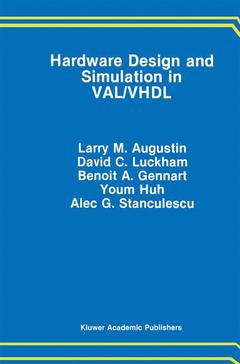Description
Hardware Design and Simulation in VAL/VHDL, 1991
The Springer International Series in Engineering and Computer Science Series, Vol. 112
Authors: Augustin Larry M., Luckham David C., Gennart Benoit A., Youm Huh , Stanculescu A.
Language: English
Subject for Hardware Design and Simulation in VAL/VHDL:
Approximative price 105.49 €
In Print (Delivery period: 15 days).
Add to cart
Publication date: 10-2012
322 p. · 15.5x23.5 cm · Paperback
322 p. · 15.5x23.5 cm · Paperback
Description
/li>Contents
/li>
The VHSIC Hardware Description Language (VHDL) provides a standard machine processable notation for describing hardware. VHDL is the result of a collaborative effort between IBM, Intermetrics, and Texas Instruments; sponsored by the Very High Speed Integrated Cir cuits (VHSIC) program office of the Department of Defense, beginning in 1981. Today it is an IEEE standard (1076-1987), and several simulators and other automated support tools for it are available commercially. By providing a standard notation for describing hardware, especially in the early stages of the hardware design process, VHDL is expected to reduce both the time lag and the cost involved in building new systems and upgrading existing ones. VHDL is the result of an evolutionary approach to language devel opment starting with high level hardware description languages existing in 1981. It has a decidedly programming language flavor, resulting both from the orientation of hardware languages of that time, and from a ma jor requirement that VHDL use Ada constructs wherever appropriate. During the 1980's there has been an increasing current of research into high level specification languages for systems, particularly in the software area, and new methods of utilizing specifications in systems de velopment. This activity is worldwide and includes, for example, object oriented design, various rigorous development methods, mathematical verification, and synthesis from high level specifications. VAL (VHDL Annotation Language) is a simple further step in the evolution of hardware description languages in the direction of applying new methods that have developed since VHDL was designed.
I A Tutorial Introduction to VAL.- 1 Introduction.- 1.1 Comparative Simulation With VAL.- 1.2 Why Extend VHDL?.- 1.3 Future Directions.- 1.4 Notation and Conventions.- 2 An Overview of VAL.- 2.1 Entity Annotations.- 2.1.1 Entity State Model.- 2.1.2 Assumptions.- 2.1.3 Statements and Processes.- 2.1.4 Timing Behavior.- 2.2 Architecture Annotations.- 2.3 Configuration Annotations.- 3 Timing Models.- 3.1 The VHDL Timing Model.- 3.1.1 Unit Delay.- 3.1.2 Transport Delay.- 3.1.3 Inertial Delay.- 3.1.4 Justification.- 3.2 The VAL Timing Model.- 3.2.1 Anticipatory Semantics.- 3.2.2 Assertions.- 4 Designing With Annotations.- 4.1 Introduction.- 4.2 Traffic Light Controller.- 4.2.1 Specification.- 4.2.2 Implementation.- 4.3 Stack.- 4.3.1 Specification.- 4.3.2 Implementation.- 4.4 Summary.- II Examples.- 5 Crazy AND Gate.- 5.1 Requirements.- 5.2 Entity Declaration.- 5.3 Commentary.- 5.3.1 Altering the Specification.- 5.3.2 Altering the Implementation.- 6 D-Type Flip-flop.- 6.1 Requirements.- 6.2 Entity Declaration.- 6.3 Commentary.- 7 Traffic Light Controller.- 7.1 Requirements.- 7.2 Entity Declaration.- 7.3 Architecture.- 7.4 Simulation Results.- 8 Stack.- 8.1 Requirements.- 8.2 Entity Declaration.- 8.3 Entity Architecture.- 8.4 Commentary.- 9 Water Heater Controller.- 9.1 Requirements.- 9.2 Entity Declaration.- 9.3 Implementation.- 9.4 Simulation Results.- 10 CPU Example.- 10.1 Requirements.- 10.1.1 Instruction level specification.- 10.1.2 Register transfer level specifications.- 10.1.3 Gate level specifications.- 10.1.4 Hierarchy of components.- 10.2 CPU Annotation methodology.- 10.2.1 Entity annotation.- 10.2.2 Mapping.- 10.3 VHDL description.- III The VAL Language Reference Manual.- 11 Lexical Elements.- 11.1 Character Set.- 11.2 Lexical Elements, Separators, and Delimiters.- 11.3 Identifiers.- 11.4 Literals.- 11.5 Comments.- 11.6 Annotations.- 11.7 Reserved Words.- 11.8 Allowable Replacements of Characters.- 11.9 BNF Notation.- 12 Design Units.- 12.1 Entity Annotations.- 12.2 Architecture Annotations.- 12.3 Configuration Annotations.- 13 State Model.- 13.1 State Model Declaration.- 13.2 State Model Type.- 14 Declarations.- 14.1 Types, Subtypes, Constants, Aliases and Use Clauses.- 14.2 Assumptions.- 14.3 Objects.- 14.4 Macros.- 15 Names and Expressions.- 15.1 Timed Expressions.- 15.2 Intervals.- 15.3 Function Call.- 16 Statements.- 16.1 Assertions.- 16.2 Drive Statement.- 16.3 Guards.- 16.4 Select.- 16.5 Generate.- 16.6 Macro Call.- 16.7 Null.- 17 Mapping Annotations.- 18 Configuration Annotations.- 19 Miscellaneous.- 19.1 Package.- 19.2 Scope and Visibility.- 19.2.1 Declarative Region and Scope of Declarations.- 19.2.2 Visibility.- 19.2.3 Use Clause.- 19.2.4 The Context of Overload Resolution.- 19.3 Attributes.- IV Transformer Implementation Guide.- 20 The VAL Transformer.- 20.1 Transformation Principles.- 20.2 Translation Methodology.- 20.3 Transformation Algorithm.- 20.3.1 Generation of Translation Skeleton.- 20.3.2 Transformation to Core VAL.- 20.3.3 Code Generation.- 20.3.4 Architecture Annotations.- 20.3.5 Configuration Annotations.- 20.4 Summary.- V Appendix.- A Syntax Summary.- A.1 Lexical Elements.- A.2 Syntax.- B CPU : VHDL description.- B.1 One bit alu.- B.2 16 bit alu.- B.3 One bit buffer.- B.4 12 bit buffer.- B.5 16 bit buffer.- B.6 CPU.- B.7 CPU configuration.- B.8 CPU support package.- B.9 CPU test bench.- B.10 Or arrays.- B.11 PLA.- B.12 One bit one output register.- B.13 16 bit one output register.- B.14 One bit two output register.- B.15 16 bit two output register.
© 2024 LAVOISIER S.A.S.
These books may interest you

The VHDL Handbook 158.24 €



